Resurgent sodium current and action potential formation in dissociated cerebellar Purkinje neurons
- PMID: 9169512
- PMCID: PMC6573347
- DOI: 10.1523/JNEUROSCI.17-12-04517.1997
Resurgent sodium current and action potential formation in dissociated cerebellar Purkinje neurons
Abstract
Voltage-dependent sodium channels were studied in dissociated cerebellar Purkinje neurons from rats. In whole-cell recordings, a tetrodotoxin (TTX)-sensitive inward current was elicited when the membrane was repolarized to voltages between -60 and -20 mV after depolarizations to +30 mV long enough to produce maximal inactivation. At -40 mV, this "resurgent" current peaked in 8 msec and decayed with a time constant of 30 msec. With 50 mM sodium as a charge carrier, the resurgent current was on average approximately 120 pA. CA3 pyramidal neurons had no such current. The current may reflect recovery of inactivated channels through open states, because in Purkinje neurons (but not CA3 neurons) there was partial recovery from inactivation at -40 mV, coinciding with the rise of resurgent current. In single-channel recordings, individual channels gave openings corresponding to resurgent and conventional transient current. Action potentials were recorded from dissociated neurons under current clamp to investigate the role of the resurgent current in action potential formation. Purkinje neurons fired spontaneously at approximately 30 Hz. Hyperpolarization to -85 mV prevented spontaneous firing, and brief depolarization then induced all-or-none firing of conglomerate action potentials comprising three to four spikes. When conglomerate action potentials were used as command voltages in voltage-clamp experiments, TTX-sensitive sodium current was elicited between spikes. The falling phase of an action potential is similar to voltage patterns that activate resurgent sodium current, and thus, resurgent sodium current likely contributes to the formation of conglomerate action potentials in Purkinje neurons.
Figures
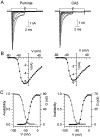
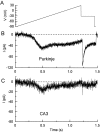
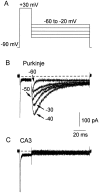
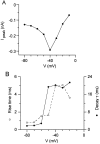


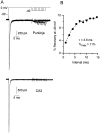
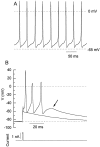
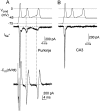
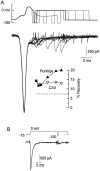
References
-
- Bell CC, Grimm RJ. Discharge properties of Purkinje cells recorded on single and double microelectrodes. J Neurophysiol. 1969;32:1044–1055. - PubMed
-
- Brown A, Schwindt P, Crill W. Different voltage dependence of transient and persistent Na+ currents is compatible with modal-gating hypothesis for Na+ channels. J Neurophysiol. 1994;71:2562–2565. - PubMed
-
- Cardozo DL, Bean BP. Voltage-dependent calcium channels in rat midbrain dopamine neurons: modulation by dopamine and GABAB receptors. J Neurophysiol. 1995;74:1137–1148. - PubMed
-
- Cepeda C, Chandler SH, Shumate LW, Levine MS. Persistent Na+ conductance in medium-sized neostriatal neurons: characterization using infrared videomicroscopy and whole-cell patch-clamp recordings. J Neurophysiol. 1995;74:1343–1348. - PubMed
-
- Crill WE. Persistent sodium current in mammalian central neurons. Annu Rev Physiol. 1996;58:349–362. - PubMed
Publication types
MeSH terms
Substances
Grants and funding
LinkOut - more resources
Full Text Sources
Miscellaneous
